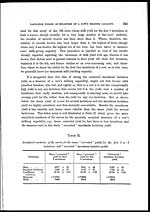Medicine - Veterinary > Veterinary colleges and laboratories > Indian journal of veterinary science and animal husbandry > Volume 3, 1933 > Original articles > Statistical studies in records of Indian dairy cattle
(308) Page 242
Download files
Individual page:
Thumbnail gallery: Grid view | List view

242 THE INDIAN JOURNAL OF VETERINARY SCIENCE AND ANIMAL HUSBANDRY [III, III.
factors already reported (Lall Chand Sikka, 1931). Only records thus standardised
have been employed. Table I below gives the chief analytical constants for these
data both " raw " and " corrected ".
TABLE I.
Analytical Constants for the " raw " and " corrected " records.
|
Constants. |
" Raw " yield. |
" Corrected " yield. |
|
Mean . . . . . |
4141 ╤ 137 |
3941 ╤ 33 |
|
Standard deviation . . |
1537 ╤ 26 |
1378 ╤ 24 |
|
Co-efficient of variation . . |
37.11 ╤ 1.06 |
34.95 ╤ 0.98 |
|
Skewness .... |
+0.2442 |
+0.1568 |
|
Mode . ... |
3766 |
3725 |
From the table of constants given above, it will be seen, that the mean of
" raw " yields is about 200 lbs. higher than the mean of " corrected " ones. This
is as it should be, since the mean service period for " uncorrected " yields is higher
than that for " corrected" ones, and since as reported earlier, a longer service
period increases the yield in a lactation and a shorter one depresses it. The skew-
ness is positive in both cases, with the result that the mode is less than the mean,
though the value of skewness of " corrected " records is definitely lower than that of
" raw " ones. The value of co-efficient of variation, though very high for both
classes of data, has decreased from 37.11 in " raw " data to 34.95 in " corrected "
data, as a result of standardisation, or by about 5.8 per cent. of its previous value.
This decrease is quite fair, especially when it is realised that we have standardised
the records only for the effect of service period, thus ignoring the effect of varia-
tions in age, dry period, and feeding and management etc. If the records had
been standardised for all these factors, then surely the value of the co-efficient of
variation would have still further decreased, and the data become more uniform.
Such a complete standardisation, however, is not possible as we have not evolved
the correction factors for variations in dry period yet, and it is not possible to
standardise records for variations in feeding and management. Furthermore,
for the study of the problem in question, it seems hardly right to use age-corrected
records, since it is the relative reliability of a cow's yield at different ages that we
are out to study.
METHODS.
Measure of Cow's milking ability.—The highest yield given by a cow in any
lactation when standardised to 85 days service period basis, has been used as a
measure of her milking capability. As has been pointed out before, records are
Set display mode to: Large image | Zoom image | Transcription
Images and transcriptions on this page, including medium image downloads, may be used under the Creative Commons Attribution 4.0 International Licence unless otherwise stated. ![]()
| Permanent URL | https://digital.nls.uk/75230398 |
|---|
| Description | Covers articles from 1933. |
|---|




